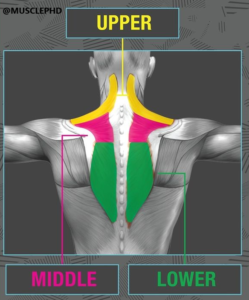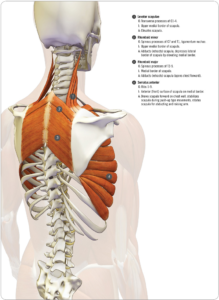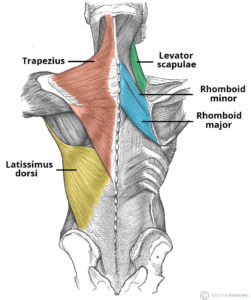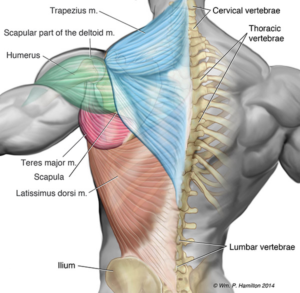MUSCLES – TRAPS | RHOMBOIDS | LEVATOR SCAPULAE
Click on Image to Enlarge
TRAPEZIUS
source: Physiopedia .
- Upper Descending part: elevates pectoral girdle[1]
- Middle part: retracts scapula[1]
- Lower Ascending part: depresses shoulders[1]
- Upper Descending and Lower Ascending together: rotates scapula upwards[1]
- Bilateral contraction: extends neck[4]
- Unilateral contraction:
RHOMBOIDS
- Scapular Retraction
- Scapular Elevation
- Scapular Rotation Inferiorly to Depress Glenoid Cavity
- Assist Serratus Anterior to Fix Scapula to Thoracic Wall and Fix Scapula during movements of the upper limb
LEVATOR SCAPULAE
- Elevates Scapula & Tilts the glenoid cavity inferiorly by rotating the scapula downward. [6]
- If the scapula is fixed, a contraction of the levator scapulae leads to the lateral flexion of the cervical vertebral column to the side and stabilizes the vertebral column during rotation.
VIDEOS
- ABELSON – DC – 18 MUSCLES OF THE SPINE – Start at 10:50
- NOTED ANATOMIST SCAPULOTHORACIC JOINT – MUSCLES & NERVES .
(1) Traps (2) Levator Scapulae (3) Rhomboids (4) Serratus Anterior (5) Pectoralis Minor (6) Subclavius - NOTED ANATOMIST – SUPERFICIAL BACK MUSCLES .
(1) Traps (2) Rhomboids (3) Levator Scapulae (4) Latissimus Dorsi - NOTED ANATOMIST – GLENOHUMERAL JOINT .
(1) Pectoralis Major (2) Teres Major (3) Latissimus Dorsi - ANATOMY ZONE – EXTRINSIC MUSCLES .
- WEBSTER – LARGE SHOULDER MUSCLES .
– Traps 6:15 | LATS 9:15 | Rhomboids 17:30 | Levator Scapulae 18:30 | Teres Major 20:20




